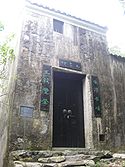
Sheung Yiu Folk Museum
Encyclopedia

Declared monuments of Hong Kong
Declared monuments of Hong Kong are places, structures or buildings legally declared to be "protected". In Hong Kong, declaring a monument requires consulting the Antiquities Advisory Board, the approval of the Chief Executive as well as the publication of the notice in government gazette.As of 12...
, on Pak Tam Chung
Pak Tam Chung
Pak Tam Chung is an area in the southern part of the Sai Kung Peninsula in the New Territories of Hong Kong. It is administratively under the Sai Kung District....
Nature Trail, Sai Kung, Hong Kong
Hong Kong
Hong Kong is one of two Special Administrative Regions of the People's Republic of China , the other being Macau. A city-state situated on China's south coast and enclosed by the Pearl River Delta and South China Sea, it is renowned for its expansive skyline and deep natural harbour...
. Sheung Yiu means "above the kiln" in Chinese.
History
Sheung Yiu Village (上窰 Hong Kong Hakka pronunciation: sɔŋ˥˧ jau˩ ) is a HakkaHakka people
The Hakka , sometimes Hakka Han, are Han Chinese who speak the Hakka language and have links to the provincial areas of Guangdong, Jiangxi, Guangxi, Sichuan, Hunan and Fujian in China....
village situated inside the Sai Kung Country Park. It was built by a Hakka family surnamed Wong late 19th century, approximately 150 years ago. The village became prosperous due to its lime kiln whose produce was much sought-after for use in mortar
Mortar (masonry)
Mortar is a workable paste used to bind construction blocks together and fill the gaps between them. The blocks may be stone, brick, cinder blocks, etc. Mortar becomes hard when it sets, resulting in a rigid aggregate structure. Modern mortars are typically made from a mixture of sand, a binder...
and fertilizer, as well as lime bricks and tiles for building houses.
It began to decline in prosperity when modern bricks and cement came into use. In the 1950s, the villagers moved away to the urban areas or went overseas to earn their living. The whole village was abandoned by the 1960s.
After the full restoration of the village in 1983, the village was opened as Sheung Yiu Folk Museum in 1984. The museum is open from 9am-4pm, from Wednesday to Sunday each week. Entrance to the museum is free. The restored building contains a number of typical Hakka utensils and farming tools, and also some displays on the history of the inhabitants.
Museum
The row of the eight houses constructed on a raised platform with a watch tower at its entrance are preserved and opened to the public. In its 9 galleries, the museum displays various farming implements, village period furniture and other daily objects used by the Hakka people so that the atmosphere and environment of a small Hakka village is recreated.The lime kiln, where coral and shells were baked to form lime, had been restored for public viewing.

